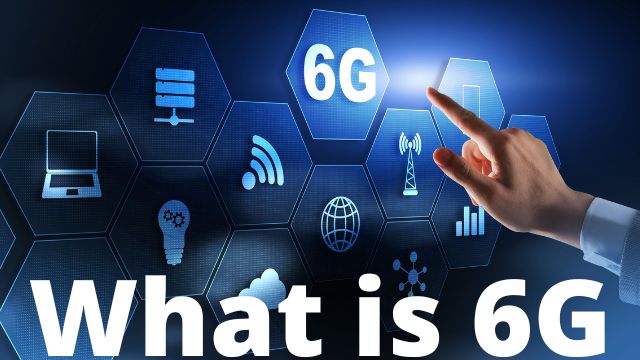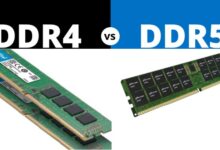What is 6G and What Will 6g Be Like

Wireless communication businesses have already begun planning for the upcoming mobile network, even if 5G wireless networks have just recently begun to take off. So, what is 6G?
6G is not technically available yet. However, theoretically, it may be many other things, building on present network and technological trends to create an entirely new kind of internet. So let’s dive into the world of 6G and speculate about what the future might bring.
What is 6G?
Fifth-generation cellular technology is replaced by sixth-generation wireless, or 6G network. The bandwidth and latency of 6G networks will be significantly higher than those of 5G networks due to their ability to operate at higher frequencies.
One of the objectives of the 6G internet is to provide communications with a one microsecond latency. This is 1,000 times faster than one millisecond throughput, or 1/1000th the latency.
The market for 6G technology is predicted to enable significant advancements in imaging, presence technologies, and location awareness.
The 6G computational infrastructure will be able to determine the ideal location for computing to occur, including choices for data storage, processing, and sharing. This capability will work in concert with artificial intelligence (AI).
It’s crucial to remember that 6G is not yet an operational technology. The industry requirements for 6G-capable network solutions are still years away, despite some vendors investing in the next-generation wireless standard.
Advantages of 6G ?
- Using transmissions at the higher end of the radio spectrum, 6G networks will function.
- Although it is too soon to predict 6G data rates, Dr. Mahyar Shirvanimoghaddam, a senior lecturer at the University of Sydney, speculated that a theoretical peak transmission rate of 1 terabyte per second for wireless communications may be feasible.
- This approximation is valid for data sent over short distances in bursts.
- In 2021, the South Korean corporation LG revealed this kind of adaptive beamforming-based technology.
- The performance of 5G apps will increase with this level of capacity and latency.
- Additionally, it will broaden the range of available capabilities to support cutting-edge developments in wireless networking, brain function, sensing, and imaging.
- With 6G, access points will be able to use orthogonal frequency-division multiple access to serve a number of customers at once.
- Due to 6G’s higher frequencies, sampling rates will be substantially faster than with 5G.
- They will also offer much greater data rates and better throughput.
- It is anticipated that the development of wireless sensing technology will be accelerated by the use of sub-mm waves, or wavelengths smaller than 1 millimeter, and frequency selectivity.
- All 6G networks will include mobile edge computing, as opposed to existing 5G networks that need to incorporate it.
- By the time 6G networks are deployed, edge and core computing will be more integrated as a part of a combined communications and computation infrastructure framework.
- As 6G technology becomes operational, this strategy will likely offer a number of benefits.
- These advantages include easier access to AI capabilities and assistance for high-end mobile systems and devices.
When will 6G be available?
In 2030, 6G internet is anticipated to go on sale. To boost capacity, reduce latency, and enhance spectrum sharing, the technology makes better use of the terahertz (THz) spectrum and distributed radio access network (RAN).
While there have been some preliminary conversations to define the technology, 6G research and development (R&D) activities really got underway in 2020.
Advanced mobile communications technologies, like cognitive and highly secure data networks, will need to be developed in order to support 6G. Additionally, spectral bandwidth growth that is several orders of magnitude quicker than 5G will be necessary.
A terahertz system-equipped 6G test satellite was launched by China. According to reports, 6G satellite launches by the tech behemoths Huawei Technologies and China Global are planned for 2021.
To prepare for the challenges of 6G, network designers must overcome many of the issues related to the deployment of millimeter wave radio for 5G.
How does 6G work?
- It is anticipated that 6G wireless technology sensing systems will use a variety of frequencies selectively to evaluate absorption and modify frequencies.
- Smartphone and other mobile network technology, as well as upcoming technologies like smart cities, driverless cars, virtual reality, and augmented reality, will all benefit from advancements in these fields.
- Because atoms and molecules produce and absorb electromagnetic radiation at distinct frequencies, and because the emission and absorption frequencies are constant for any given substance, this method is feasible.
Many government and business strategies for ensuring the protection of vital assets and the general public will be significantly impacted by 6 g internet, including the ones listed below:
- Threat detection;
- Health monitoring;
- Feature and facial recognition;
- Decision-making in areas like law enforcement and social credit systems;
- Air quality measurements;
- Gas and toxicity sensing; and
- Sensory interfaces that feel like real life.
Do we even need 6G?
There are several factors that make 6G wireless technology necessary. These are a few of them:
- Technology convergence
- Edge Computing
- Internet of Things
- High Performance Computing
- Technology convergence
Deep learning and big data analytics will be integrated into the sixth generation of mobile networks, which will bring together hitherto unrelated technology. A large portion of this convergence has been made possible by the launch of 5G.
- Edge computing
A key force behind the development of 6G wireless technology is the requirement for edge computing deployment to guarantee high overall throughput and low latency for ultrareliable, low-latency communications solutions.
- Internet of things (IoT)
The necessity to support machine-to-machine communication in IoT is another motivating factor.
- High-performance computing (HPC)
A strong relationship has been identified between 6G wireless technology and Hight performance computing, While edge computing resources will handle some of the IoT and mobile technology data, much of it will require more centralized HPC resources to do the processing.
- 5 Internet Generation- A complete Knowledgeable Guide
- What is IoT (Internet of Things) and How Does it Work?
- No internet, No cash: How To Still Use UPI To Send Money Without Internet?
Who is working on 6G ?
Many players in the industry are paying attention to the race to 6G wireless technology. Keysight Technologies, a test and measurement company, has dedicated to its development.
Major infrastructure providers including Huawei, Nokia, and Samsung have hinted that they are conducting 6G wireless technology research and development.
When compared to the race to determine which nations and firms would dominate the 6G wireless technology market and its associated applications and services, the race to attain 5G may turn out to be a formality.
The following are some of the large projects in progress:
- To create a 6G wireless technology vision for 2030, the University of Oulu in Finland has started the 6Genesis research project. To oversee the work of the Finnish 6G Flagship research on 6G technologies, the institution has also inked a cooperative agreement with Japan’s Beyond 5G Promotion Consortium.
- The Terahertz frequency band for 6G network is the subject of research by the Electronics and Telecommunications Research Institute of South Korea. It anticipates data speeds that are five times faster than those of 5G networks and 100 times faster than those of 4G Long-Term Evolution (LTE) networks.
- The Ministry of Industry and Information Technology of China is funding and supervising 6G network research and development in the nation.
- 2020 will see the opening of the 6G network frequency for spectrum testing for frequencies exceeding 95 GHz to 3 THz by the U.S. Federal Communications Commission (FCC).
- A European group of academic and business authorities called Hexa-X is advancing the study of 6G network standards. That project is being led by the Finnish communications corporation Nokia, which is also working with the Swedish operator Ericsson and the Italian operator TIM.
- Researchers from Adelaide University in Australia and Osaka University in Japan have created a silicon-based microprocessor with a unique multiplex to partition data and allow for more effective handling of terahertz radiation. The device allegedly delivered data at a rate of 11 gigabits per second during testing, above the theoretical 10 Gbps 5G limit.
Future scope of 6G technology
The term “Beyond 4G” (B4G) was first used to describe the necessity of advancing the evolution of 4G beyond the LTE standard about ten years ago.
Only R&D-level prototypes at the time, prior to standards, were being developed, therefore it remained unclear what 5G may involve.
B4G was in use for a while. It made reference to potential developments after 4G. Ironically, some of the LTE standard’s features will be used in 5G.
As with B4G, 6G technologies are anticipated to replace fifth-generation capabilities and applications. The numerous LTE, 5G, and edge computing implementations of private wireless communications for business and industrial users have paved the way for 6G.
6G wireless networks of the future will go one step farther in this. They will build a network of communication service providers, many of which will act as self-providers, much like photovoltaic solar power has led to cogeneration inside the smart grid.
Mesh networks could benefit from 6G’s conceptual and practical advancements, enabling coverage to be expanded past the limitations of earlier cell towers.
Big 5G-driven changes are already affecting data centers. These include challenges with the concurrent support of public and private networks, edge computing, programmable networks, and virtualization.
As an illustration, some commercial clients could desire to mix on-premises RAN with hybrid on-premises and hosted computing — for edge and core computing, respectively — and data center-hosted core network elements for private business networks or alternative service providers.
6G radio networks will offer the data collection and transmission required to assemble information. For the 6G technology industry, a systems strategy that uses data analytics, AI, and next-generation processing capabilities including HPC and quantum computing is necessary.
Due to the convergence of numerous new technologies, 6G will not only result in significant changes to RAN technology but also to the core communications network fabric. Notably, 6G will put AI front and center.
The following are further modifications that 6G is likely to bring:
- Nano-core
- Edge and core coordination
- Data management
- Nano-core
It is anticipated that a so-called nano-core will develop as a universal computing core that integrates aspects of HPC and AI. It is not necessary for the nano-core to be a physical network component.
Alternatively, it might refer to a logical grouping of computational resources that are utilized by numerous networks and systems.
- Edge and core coordination
In comparison to 5G networks, 6G networks will generate significantly more data, and computing will advance to incorporate coordination between edge and core platforms. Data centers will need to adapt in reaction to these changes.
- Data management
Huge volumes of data will be produced by 6G’s sensing, imaging, and location-based capabilities, which must be handled on behalf of the network owners, service providers, and data owners.
What is the Difference Between 5G and 6G
| 5G | 6G |
| Band Frequency Sub-6 GHz (Gigahertz) to above 24.25 GHz | Band Frequency 95 GHz to 3 THz (Terahertz) |
| up to 20 Gbps | 1,000 gigabits/s peak data rate |
| Latency- 5m | Latency- 1millisecond to 1microsecond |
Conclusion
Even though there is no 6G network yet and it is only in the research stage, businesses have begun to imagine cutting-edge wireless use cases with 6G technology after a successful comparison of 5G vs. 6G network.
The major goal is to enter a new era of wireless technology and introduce new inventions that will change the world in the future years. Once the latest wireless network generation, or 6G mobile network, strikes the telecom sector on a wider zone, highly exciting prospects with regard to speed and dependability are projected to become a reality soon.
The way we live or conduct business electronically today and in the post-covid era will undoubtedly take on new dimensions thanks to this cutting-edge technology, making it as convenient as possible.
People May Ask
Q- How does 6G work?
A- Sixth generation is abbreviated 6G. It will follow 5G and 4G as the most recent wireless internet and communication standards.
Q- Describe 6G.
A- The term “6G” refers to a set of concepts and hypotheses regarding how the mobile network, Wi-Fi gadgets, linked cars, and other Wi-Fi-connected objects will look and feel in around ten years. It is wireless internet as it will be in the future, according to researchers and businesses.
Q- How will 6G appear?
A- Although it is difficult to predict exactly what 6G will look like, it is likely to entail a high degree of automation and connectivity in automobiles, drones, mobile devices, homes, and industries. Additionally, it will use cutting-edge “edge” technologies like artificial intelligence.
Q- What is a 6G base station?
A- A wireless communications base station called a 6G base station is used to receive and send cellular signals. The 4G LTE and 5G networks employ cell towers and “small cells,” which are tiny transmitters placed on street corners and utility poles, to beam internet and cellular data to our phones and other wireless devices, even though base stations for 6G aren’t yet available.






